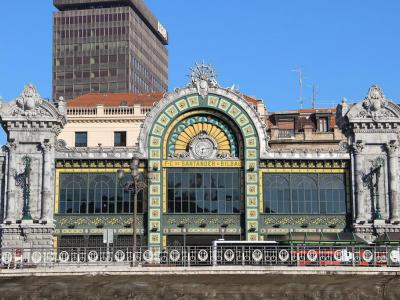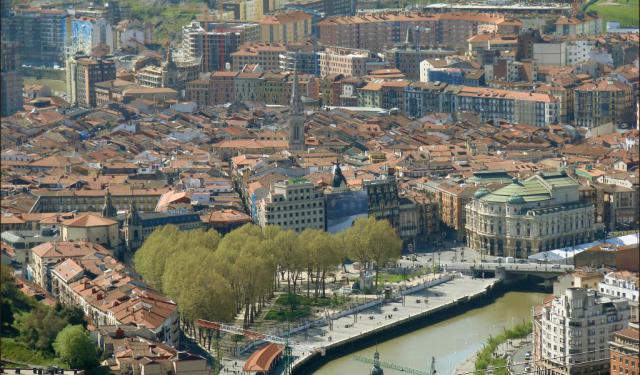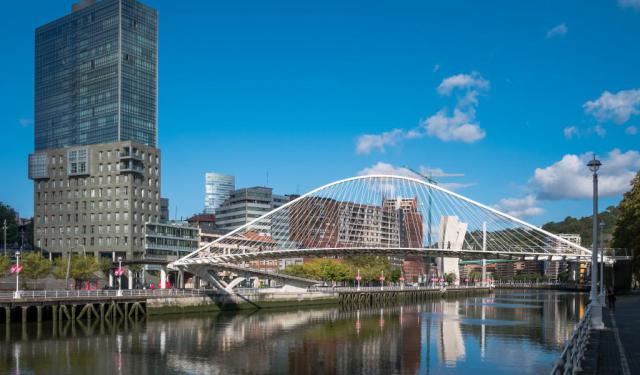
Estacion de Bilbao Concordia (Bilbao-Concordia Railway Station), Bilbao
The Bilbao-Concordia Railway Station, also known as Santander Station, is the terminus for suburban lines offering medium and some long-distance services. The facade is Modernist in style and is considered an outstanding example of Belle Epoque architecture in Bilbao. The station was opened in 1898 and completed in 1902. It sits beside the Bilbao River.
The station idea was put forward by engineer Valentin Gorbeña. Gorbeña was also the builder of the Kadagua Railway. The station design was by architect Severino Achucarro. He had already assisted in the plan for the ensanche (widening) of the town in 1876. The name "Concordia" is from an agreement by investors to save the railway from bankruptcy.
The station is two stories high. The ground floor houses the main hall, cafeteria, ticket machines, and offices. The main entrance is on Bailen Street by the river. The rear access opens on Jose Maria Olavarri Street. Tracks and platforms are on the second floor.
The entrance facade is structured with painted iron masonry with large area openings for illumination. The center facade features a semicircular arch with a clock flanked by two lampposts. The pavilion has a Doric colonnade open to the platforms. The interior iron architecture has capitals featuring Hermes, the God of Commerce, and borders.
The station idea was put forward by engineer Valentin Gorbeña. Gorbeña was also the builder of the Kadagua Railway. The station design was by architect Severino Achucarro. He had already assisted in the plan for the ensanche (widening) of the town in 1876. The name "Concordia" is from an agreement by investors to save the railway from bankruptcy.
The station is two stories high. The ground floor houses the main hall, cafeteria, ticket machines, and offices. The main entrance is on Bailen Street by the river. The rear access opens on Jose Maria Olavarri Street. Tracks and platforms are on the second floor.
The entrance facade is structured with painted iron masonry with large area openings for illumination. The center facade features a semicircular arch with a clock flanked by two lampposts. The pavilion has a Doric colonnade open to the platforms. The interior iron architecture has capitals featuring Hermes, the God of Commerce, and borders.
Want to visit this sight? Check out these Self-Guided Walking Tours in Bilbao. Alternatively, you can download the mobile app "GPSmyCity: Walks in 1K+ Cities" from Apple App Store or Google Play Store. The app turns your mobile device to a personal tour guide and it works offline, so no data plan is needed when traveling abroad.
Estacion de Bilbao Concordia (Bilbao-Concordia Railway Station) on Map
Sight Name: Estacion de Bilbao Concordia (Bilbao-Concordia Railway Station)
Sight Location: Bilbao, Spain (See walking tours in Bilbao)
Sight Type: Attraction/Landmark
Guide(s) Containing This Sight:
Sight Location: Bilbao, Spain (See walking tours in Bilbao)
Sight Type: Attraction/Landmark
Guide(s) Containing This Sight:
Walking Tours in Bilbao, Spain
Create Your Own Walk in Bilbao
Creating your own self-guided walk in Bilbao is easy and fun. Choose the city attractions that you want to see and a walk route map will be created just for you. You can even set your hotel as the start point of the walk.
Bilbao's Old Town Walking Tour
Bilbao's old town, also known as The Seven Streets, is the medieval heart of the city. Indeed, this ancient neighborhood, a place where the city began and which had been fortified by walls until the late 19th century, today consists of seven main streets and many narrow alleys – called cantons (kantoi, cantón) – that connect them.
Often regarded as a jewel of Basque architecture and... view more
Tour Duration: 1 Hour(s)
Travel Distance: 1.6 Km or 1 Miles
Often regarded as a jewel of Basque architecture and... view more
Tour Duration: 1 Hour(s)
Travel Distance: 1.6 Km or 1 Miles
Bilbao Introduction Walking Tour
Bilbao is the largest city in northern Spain. Burial sites 6,000 years old have been found near Bilbao. A settlement of the 3rd or 2nd century BC was called Amanun Portus by the Roman writer Pliny the Elder. Ptolemy referred to it as Flaviobriga.
But today's Bilbao was founded on the banks of the Nervion River by the Lord of Biscay in the year 1300. The city was an important trading hub... view more
Tour Duration: 2 Hour(s)
Travel Distance: 4.1 Km or 2.5 Miles
But today's Bilbao was founded on the banks of the Nervion River by the Lord of Biscay in the year 1300. The city was an important trading hub... view more
Tour Duration: 2 Hour(s)
Travel Distance: 4.1 Km or 2.5 Miles


